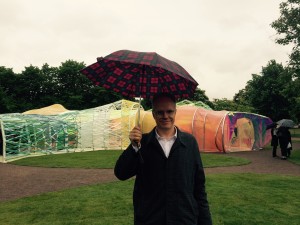
Hans-Ulrich Obrist, co-director of the Serpentine Gallery, about jet-setting garden sheds and the opening of the 15th summer pavilion in London’s Kensington Gardens.
„Art Review“ has called Hans-Ulrich Obrist the most influencial curator of today. The 46 year old Swiss has been Co-director of the Serpentine Gallery with Julia Peyton-Jones since 2006. Obrist is one of the most renowned experts on contemporary art, but he has another strong side, too: With seemingly endless energy he attracts sponsors to invest in his projects, artists and exhibitions.
Obrist lives and works in London, at least theoretically. Most days he spends on the road. In his spare time, which does not exist, he conducts interviews with artists and art managers. The results of these 2400 hours are published in dozens of books. His last one is called „Ways of curating“. HUO, as he is often called to save time, is driven. But at the same time he looks completely relaxed when he poses for a picture to present his summer pavilion by Spanish architects Selgascano - under an umbrella in the pouring London summer rain.
TS: This is the 15th summer pavilion. How often can you repeat the miracle?
HUO: We are more thrilled than ever. When the project started in 2000 it was extremely important to bring the big figures of contemporary architecture to London. England is highly insular. Other than in Austria, Switzerland or Germany all the big names of the international architecture scene had never build anything in London until 15 years ago. Mies van der Rohe or Walter Gropius? Never. Oscar Niemeyer? Everywhere in Europe, but never in England. And then my co-director Julia invented the summer pavilion and invited the big names. Since 2006 I help her do that. You have to imagine: The first thing Frank Gehry built in the United Kingdom was our summer pavilion in the Serpentine Gallery in 2008.
TS: Even a big star among the UK immigrant scene like the Iraqi-British architect Zaha Hadid had for the longest time not been invited to build a project here.
HUO: Incredible, isn’t it? Zaha Hadid or Rem Kolhaas, they lived here for decades, studied here, but worked on projects all over the world but London. Hadid was the first one to be invited by Julia to plan a summer pavilion in 2000. This goes to show how important this tiny project has been.
TS: This ironic concept worked: You broke up the old structures of the big British institutions with a little garden shed. But by now even the highest skyscraper of London, the Shard, was created by a foreign architect, the Italian Renzo Piano. So where do you take the concept of the pavilion now?
HUO: I am not sure it was ironic, it was certainly a playful concept. In architecture you always deal with a lot of bureaucracy, planning permits, restrictions. How you can build and how you are not allowed to build. The garden shed as concept in contrast is a playground for ideas, because nobody takes it so seriously. But you are right: London today has become a much more global city. After the first phase with important international architects we had to move on. We needed a new concept. We see a lot of new projects throughout the year and realized that there is a whole new generation of architects. It takes longer in architecture than in contemporary art until positions become visible. Artists often exhibit in their Twenties, Thirties. Until an architect builds his own office it takes time. They often work for years in someone else’s studio to gain experience. Architects often only start building in their Forties.
TS: It also costs more to build a skyscraper than a sculpture.
HUB: True. During our research into the young generation of architects we found Smiljan Radic, Sou Fujimoto and now: Selgascano. There is no end in sight. This brought new life to our pavilion scheme. It is sustainable – each pavilion is sold and stands somewhere else in the end. This one will go to Los Angeles and I am looking forward to seeing how it will change in the Californian light. Nothing is being thrown away, everything is recycled. This concept is not totally new. The pavilion of Mies van der Rohe (developed for the International Exhibition in 1929) is still there in Barcelona.
TS: Sounds a bit like garden shed jet set...
HUO: The idea that the pavilion travels did not come out of pure pleasure, it was a necessity to produce and finance a sustainable project. It’s unique in the world, it is like a Jour Fixe. Every June people are excited to see what we came up with this year. These rituals are important. The Russian filmmaker Andrei Tarkovsky sad the problem of our time is that rituals disappear and that we should think of new ones. My taxi driver told me yesterday how much he is looking forward seeing the new pavilion. It has become a ritual for all of London. Each year we have a million visitors in the Serpentine Gallery. 200.000 of these visit the pavilion. It is a very public ritual. There is no entry fee. It is so important to take down the threshold to museums. Art should not only be available to those who are experts. It should be free for all. Every year the runners in Hyde Park find ways to use the pavilion for their purpose. Olafur Eliasson created one with ramps which runners ran up and down on. It is very playful. You do not have to consume anything. People come to read the newspaper, use the pavilion as meeting point. During the summer there are Park Nights with cinema and concerts. It is a very egalitarian, democratic project. In America people have to pay 22 Dollars to go into a museum. This excludes half of the population from enjoying art. The market dominates everything. We need need resolute democratic rituals.
TS: National museums in Great Britain are generally free since 2001. Visitors pay only for special exhibitions. There is no entry fee to your summer pavilion, but the opening party is one of the very special events for the High Society of London. Is this not a total contradiction to your call for „resolute democratic rituals“?
HUO: The summer party is our fund raiser. We cannot change this. If we do not have a sponsor, we cannot give free entry.
TS: Is this not irritating for you, having been raised in Central European traditions, that everything needs a sponsor - otherwise it does not happen? Banks gain therefore a lot of influence into shaping public life.
HUO: Of course, but often the result is a highly interesting dialogue with the supporting companies. This year Goldmann Sachs is our sponsor.
TS: The investment bank from New York is known to be a champion of democracy...
HUO (laughing): It is important that these companies support our projects. Otherwise they would simply not exist.


